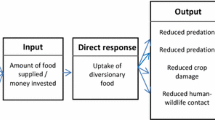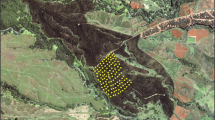Abstract
Diversionary feeding (i.e. supplementary feeding used to mitigate damage to human activities) is a management tool widely employed to avoid human-wildlife conflicts, which could alter the spatial behaviour of target species and can also affect other species present in the area, among other effects. We evaluated the effect of diversionary feeding in the spatial behaviour of the aoudad (Ammotragus lervia), an exotic ungulate associated with crop damage in the area, and we assessed the use of diversionary feeding stations (DFS) by non-target species. Nine aoudads were tracked with GPS/GSM collars. We compared their core home ranges and number of GPS locations in the DFS before and meanwhile food was available on them. Eight DFS were monitored with cameras to identify which species used the feeding sites. The home ranges changed for some individuals, but this variation was not related to supplementary feeding. Just five out of the nine tracked aoudads used DFS, and the number of GPS locations in the DFS by aoudad increased when food was available. DFS were used by fifteen non-target species of birds and mammals, and especially by the wild boar. Aoudads and wild boars segregated temporally but not spatially in their use of the DFS. Our study suggests that diversionary feeding had a limited effect on the spatial behaviour of the aoudad, suggesting that its effectiveness to reduce crop damage may be restricted.


Similar content being viewed by others
References
Agencia Estatal de Meteorología (2015) Informe estacional climatológico verano 2015. Ministerio de Agricultura, Alimentación y Medio Ambiente, Madrid
Agencia Estatal de Meteorología (2016) Informe anual 2015. Ministerio de Agricultura y Pesca, Alimentación y Medio Ambiente, Madrid
Amici A, Serrani F, Rossi CM, Primi R (2012) Increase in crop damage caused by wild boar (Sus scrofa L.): the “refuge effect”. Agron Sustain Dev 32:683–692
Anadón JD, Pérez-García JM, Pérez I, Royo J, Sánchez-Zapata JA (2018) Disentangling the effects of habitat, connectivity and interspecific competition in the range expansion of exotic and native ungulates. Landsc Ecol 33:597–608
Apollonio M, Andersen R, Putman R (2010) European ungulates and their management in the 21st century. Cambridge University Press, Cambridge
Bates D, Maechler M, Bolker B, Walker S (2015) Fitting linear mixed-effects models using lme4. J Stat Softw 67:1–48
Bergmüller R, Taborsky M (2010) Animal personality due to social niche specialisation. Trends Ecol Evol 25:504–511
Bergvall UA, Schäpers A, Kjellander P, Weiss A (2011) Personality and foraging decisions in fallow deer, Dama dama. Anim Behav 81:101–112
Blanco G, Lemus JA, García-Montijano M (2011) When conservation management becomes contraindicated: impact of food supplementation on health of endangered wildlife. Ecol Appl 21:2469–2477
Bleier N, Lehoczki R, Újváry D, Szemethy L, Csányi S (2012) Relationships between wild ungulates density and crop damage in Hungary. Acta Theriol (Warsz) 57:351–359
Bowman B, Belant JL, Beyer DE Jr, Martel D (2015) Characterizing non target species use at bait sites for white-tailed deer. Hum Wildl Interact 9:110–118
Calenge C (2006) The package “adehabitat” for the R software: a tool for the analysis of space and habitat use by animals. Ecol Model 197:516–519
Cassinello J (1998) Ammotragus lervia: a review on systematics, biology, ecology and distribution. Ann Zool Fennici 35:149–162
Colino-Rabanal V, Bosch J, Muñoz MJ, Peris SJ (2012) Influence of new irrigated croplands on wild boar (Sus scrofa) road kills in NW Spain. Anim Biodivers Conserv 35:247–252
Corcoran MJ, Wetherbee BM, Shivji MS, Potenski MD, Chapman DD, Harvey GM (2013) Supplemental feeding for ecotourism reverses diel activity and alters movement patterns and spatial distribution of the southern stingray, Dasyatis americana. PLoS ONE 8:e59235
Cortés-Avianza A, Blanco G, DeVault TL, Markandya A, Virani MZ, Brandt J, Donázar JA (2016) Supplementary feeding and endangered avian scavengers: benefits, caveats and controversies. Front Ecol Environ 14:191–199
Diamond M (1975) Assembly of species communities. In: Cody ML, Diamond JM (eds) Ecology and evolution of communities. Belknap Press, Cambridge, pp 342–444
Dunkley L, Cattet MRL (2003) A comprehensive review of the ecological and human social effects of artificial feeding and baiting of wildlife. Can Coop Wildl Health Centre Newslett Publ 21:1–68
Eguía S, Botella F, Giménez A, Sánchez-Zapata JA, Pascual R, García-Martínez Noguera EJ, Fuertes F, Pérez-Morales A, Morell M (2015) Elaboración del Plan de Gestión del Arruí en la Región de Murcia. Consejería de Agua, Agricultura y Medioambiente, Región de Murcia
Fox J, Bouchet-Valat M (2017) Rcmdr: R commander. R package version, vol 2, pp 3–2
Geisser H, Reyer HU (2004) Efficacy of hunting, feeding, and fencing to reduce crop damage by wild boars. J Wildl Manag 68:939–946
González LM, Margalida A, Sánchez R, Oria J (2006) Supplementary feeding as an effective tool for improving breeding success in the Spanish imperial eagle (Aquila adalberti). Biol Conserv 129:477–486
González-Candela M (2002) Epidemiología de sarna sarcóptica (Sarcoptes scabiei) en la población de arruí (Ammotragus lervia) del Parque Regional de Sierra Espuña (Murcia). Doctoral thesis. Universidad de Murcia
Gortázar C, Acevedo P, Ruiz-Fons F, Vicente J (2006) Disease risks and overabundance of game species. Eur J Wildl Res 52:81–87
Griffith DM, Veech JA, Marsh CJ (2016) Cooccur: probabilistic species co-occurrence analysis in R. J Stat Softw 69:1–17
Gundersen H, Andreassen HP, Storaas T (2004) Supplemental feeding of migratory moose Alces alces: forest damage at two spatial scales. Wildl Biol 10:213–223
Harris S, Cresswell WJ, Forde PG, Trewhella WJ, Woollard T, Wray S (1990) Home-range analysis using radio-tracking data: a review of problems and techniques particularly as applied to the study of mammals. Mamm Rev 20:97–123
Inslerman RA, Miller JE, Baker DL, Kennamer JE, Cumberland R, Stinson ER, Doerr P, Williamson SJ (2006) Baiting and supplemental feeding of game wildlife species. Bethesda, Maryland
Krofel M, Jerina K (2016) Mind the cat: conservation management of a protected dominant scavenger indirectly affects an endangered apex predator. Biol Conserv 197:40–46
Kubasiewicz LM, Bunnefeld N, Tulloch AIT, Quine CP, Park KJ (2016) Diversionary feeding: an effective management strategy for conservation conflict? Biodivers Conserv 25:1–22
Langley RB (1999) Dilution of precision. In: GPS World, vol 10, pp 52–59
Langvatn R, Albon SD, Burkey T, Clutton-Brock TH (1996) Climate, plant phenology and variation in age of first reproduction in a temperate herbivore. J Anim Ecol 65:653–670
López-Bao JV, Rodríguez A, Palomares F (2008) Behavioural response of a trophic specialist, the Iberian lynx, to supplementary food: patterns of food use and implications for conservation. Biol Conserv 141:1857–1867
Margalida A, Pérez-García JM, Moreno-Opo R (2017) European policies on livestock carcasses management did not modify the foraging behavior of a threatened vulture. Ecol Indic 80:66–73
Milner JM, Van Beest FM, Schmidt KT, Brook RK, Storaas T (2014) To feed or not to feed? Evidence of the intended and unintended effects of feeding wild ungulates. J Wildl Manag 78:1322–1334
Miranda M, Sicilia M, Bartolomé J, Molina-Alcaide E, Gálvez-Bravo L, Cassinello J (2012) Contrasting feeding patterns of native red deer and two exotic ungulates in a Mediterranean ecosystem. Wildl Res 39:171–182
Miranda M, Cristóbal I, Díaz L, Sicilia M, Molina-Alcaide E, Bartolomé J, Fierro Y, Cassinello J (2015) Ecological effects of game management: does supplemental feeding affect herbivory pressure on native vegetation? Wildl Res 42:353–361
Muñoz PM, Boadella M, Arnal M, de Miguel MJ, Revilla M, Martínez D, Vicente J, Acevedo P, Oleaga A, Ruiz-Fons F, Marín CM, Prieto JM, de la Fuente J, Barral M, Barberán M, de Luco D, Blasco JM, Gortázar C (2010) Spatial distribution and risk factors of brucellosis in Iberian wild ungulates. BMC Infect Dis 10:1–14
Oja R, Zilmer K, Valdmann H (2015) Spatiotemporal effects of supplementary feeding of wild boar (Sus scrofa) on artificial ground nest depredation. PLoSONE 10:e0135254
Orams MA (2002) Feeding wildlife as a tourism attraction: a review of issues and impacts. Tour Manag 23:281–293
Ostfeld RS, Keesing F (2000) Pulsed resources and community dynamics of consumers in terrestrial ecosystems. Trends Ecol Evol 15:232–237
Pascual-Rico R, Morugán-Coronado A, Botella F, García-Orenes F, Sánchez-Zapata JA (2018) Soil properties in relation to diversionary feeding stations for ungulates on a Mediterranean mountain. Appl Soil Ecol 127:136–143
Pedersen S, Mathisen KM, Gorini L, Andreassen HP, Røskaft E, Skarpe C (2014) Small mammal responses to moose supplementary winter feeding. Eur J Wildl Res 60:527–534
Piper SE (2005) Supplementary feeding programs: how necessary are they for the maintenance of numerous and healthy vultures populations? In: Houston DC, Piper SE (eds) Proceedings of the international conference on conservation and management of vulture populations. Natural History Museum of Crete & WWF Greece, Thessaloniki, pp 41–50
Putman RJ, Staines BW (2004) Supplementary winter feeding of wild red deer Cervus elaphus in Europe and North America: justifications, feeding practice and effectiveness. Mamm Rev 34:285–306
Redpath SM, Young J, Evely A, Adams WM, Sutherland WJ, Whitehouse A, Amar A, Lambert RA, Linnell JDC, Watt A, Gutiérrez RJ (2013) Understanding and managing conservation conflicts. Trends Ecol Evol 28:100–109
Robb GN, McDonald RA, Chamberlain DE, Bearhop S (2008) Food for thought: supplementary feeding as a driver of ecological change in avian populations. Front Ecol Environ 6:476–484
Sahlsten J, Bunnefeld N, Månsson J, Ericsson G, Bergström R, Dettki H (2010) Can supplementary feeding be used to redistribute moose Alces alces? Wildl Biol 16:85–92
Selva N, Berezowska-Cnota T, Elguero-Claramunt I (2014) Unforeseen effects of supplementary feeding: ungulate baiting sites as hotspots for ground-nest predation. PLoSONE 9:e90740
Snow NP, Porter WF, Williams DM (2015) Underreporting of wildlife-vehicle collisions does not hinder predictive models for large ungulates. Biol Conserv 181:44–53
Sorensen A, van Beest FM, Brook RK (2014) Impacts of wildlife baiting and supplemental feeding on infectious disease transmission risk: a synthesis of knowledge. Prev Vet Med 113:356–363
Veech JA (2013) A probabilistic model for analysing species co-occurrence. Glob Ecol Biogeogr 22:252–260
Velamazán M, San Miguel A, Escribano R, Perea R (2017) Threatened woody flora as an ecological indicator of large herbivore introductions. Biodivers Conserv 26:917–930
Velamazán M, San Miguel A, Escribano R, Perea R (2018) Use of firebreaks and artificial supply points by wild ungulates: effects on fuel load and woody vegetation along a distance gradient. For Ecol Manag 427:114–123
Wilson ADM, McLaughlin RL (2007) Behavioural syndromes in brook charr, Salvelinus fontinalis: prey-search in the field corresponds with space use in novel laboratory situations. Anim Behav 74:689–698
Wilson ADM, Stevens ED (2005) Consistency in context-specific measures of shyness and boldness in rainbow trout, Oncorhynchus mykiss. Ethol 111:849–862
Worton BJ (1989) Kernel methods for estimating the utilization in home-ranges studies. Ecol 70:164–168
Yang LH, Bastow JL, Spence KO, Wright AN (2008) What can we learn from resource pulses? Ecol 89:621–634
Acknowledgements
We thank the veterinary (F. Escribano), public gamekeepers (C. Esteban, J. J. Rodríguez, F. Yepes), rangers (Evaristo) and the Ministry of Tourism, Culture and Environment of Murcia Region. RPR was supported by a pre-doctoral grant from the Spanish Ministry of Education (FPU13/05460), and the study was partially supported by MINECO and ERDF (projectCGL2015-66966-C2-1-R). JMPG and ESG were supported by a Juan de la Cierva research contract by the Ministry of Economy and Competitiveness (FJCI-2015-25632 and IJCI-2015-24947). GPS collars were partially supported by the European Regional Development Fund (ERDF) of the European Union (P.O. 2007/2013).
Author information
Authors and Affiliations
Corresponding author
Ethics declarations
Conflict of interest
The authors declare that they have no conflict of interest.
Human and animal studies
All applicable international, national and/or institutional guidelines for the care and use of animals were followed.
Electronic supplementary material
ESM 1
(DOCX 28 kb)
Rights and permissions
About this article
Cite this article
Pascual-Rico, R., Pérez-García, J.M., Sebastián-González, E. et al. Is diversionary feeding a useful tool to avoid human-ungulate conflicts? A case study with the aoudad. Eur J Wildl Res 64, 67 (2018). https://doi.org/10.1007/s10344-018-1226-6
Received:
Revised:
Accepted:
Published:
DOI: https://doi.org/10.1007/s10344-018-1226-6




